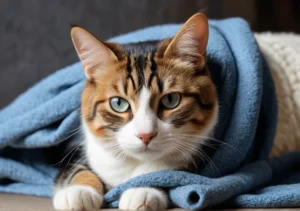Cats are known for their playful and sometimes unpredictable behavior. One puzzling habit that some cat owners may notice is their feline friends attacking weighted blankets. But why do cats exhibit this behavior? Let’s explore the reasons behind why cats attack weighted blankets.
The Appeal of Weighted Blankets to Cats
Weighted blankets can be surprisingly appealing to our feline friends for a few reasons. Cats are naturally drawn to warm, cozy spots, and a weighted blanket provides just that. The added weight of the blanket may remind them of the pressure they enjoy when snuggled up against their favorite human or another furry friend.
Moreover, cats are known to seek out small, confined spaces for comfort and security. A weighted blanket draped over a couch or bed can create a secluded spot that feels safe and comforting to a cat. The gentle pressure from the blanket can mimic the feeling of being held or hugged, which many cats find comforting.
Additionally, the texture of a weighted blanket can be intriguing to cats. The soft, plush fabric may feel pleasant to knead or paw at, providing a sensory experience that cats may find engaging and enjoyable. The combination of warmth, weight, and texture makes weighted blankets a tempting spot for cats to explore and interact with.
Sensory Stimulation and Comfort
The sensory stimulation provided by weighted blankets can be particularly appealing to cats. The gentle pressure from the blanket can offer a sense of security and calmness to cats, especially those who may be prone to anxiety or stress. The weight of the blanket can help create a sense of grounding for cats, which can be soothing and comforting.
Moreover, the texture of the blanket can offer tactile stimulation for cats. Cats have sensitive paws and may enjoy kneading or exploring the soft fabric of a weighted blanket. This tactile experience can be both relaxing and entertaining for cats, making them more likely to interact with the blanket.
In addition to sensory stimulation, the warmth provided by a weighted blanket can be alluring to cats. Cats are known to seek out warm spots for lounging, and a weighted blanket can offer a cozy and inviting place for them to relax. The combination of sensory stimulation, comfort, and warmth makes weighted blankets a tempting target for our curious feline companions.
Additional Unique Insight:
Cats may also attack weighted blankets out of a sense of playfulness. The texture and weight of the blanket can make it an enticing target for a cat looking for a source of entertainment. Pouncing on the blanket, pawing at it, or even digging at it can all be ways for cats to engage their natural hunting instincts and have some fun. So, while cats may attack weighted blankets out of curiosity or comfort, they may also do so simply for the thrill of play.
Mimicking Prey Behavior
Cats attacking weighted blankets may stem from their natural hunting instincts. To a cat, the blanket’s weight and texture could resemble that of prey, triggering their predatory instincts. This behavior is a way for them to practice their hunting skills and engage in a form of play. Providing your cat with interactive toys and play sessions can help redirect this behavior and satisfy their need for play and stimulation.
Mental Stimulation and Playfulness
Attacking a weighted blanket can offer mental stimulation and entertainment for cats. The challenge of pouncing on and ‘capturing’ the moving blanket can keep them engaged and active. It also provides an outlet for their playful energy, preventing boredom and potential destructive behavior. Offering a variety of toys, scratching posts, and interactive playtime can help keep your cat entertained and mentally stimulated.
Additional Unique Insight: Introducing puzzle feeders or food-dispensing toys can further stimulate your cat mentally and physically while encouraging natural hunting behaviors. This interactive feeding method can provide cognitive challenges and keep your cat engaged during meal times.
Scent Marking and Territory
Cats have a strong instinct to mark their territory, and attacking a weighted blanket may be a way for them to do so. By clawing and biting at the blanket, they are leaving behind their scent through their saliva and pheromones, effectively claiming the blanket as their own. In the wild, this behavior helps cats establish boundaries and assert dominance. So, if your feline friend is attacking your weighted blanket, it could be their way of declaring ownership over that particular space.
Possible Solutions for Cat Owners
If your cat is attacking your weighted blanket, there are several strategies you can try to redirect their behavior. One effective method is to provide alternative outlets for your cat’s energy, such as interactive toys or scratching posts. Additionally, you can try using deterrents like double-sided tape or aluminum foil on the blanket to discourage them from attacking it. Another helpful tip is to spend quality time playing with your cat to tire them out and prevent them from seeking out the blanket as a target for play.
- Try rotating your cat’s toys regularly to keep them engaged and entertained.
- Consider providing vertical spaces for your cat to climb and explore, such as cat trees or shelves.
- Consult with your veterinarian to rule out any underlying medical issues that may be causing your cat’s behavior.
Remember, patience and consistency are key when it comes to modifying your cat’s behavior. By implementing these strategies and understanding the reasons behind your cat’s behavior, you can create a harmonious environment for both you and your furry friend.
Fun Facts About Cats and Their Behavior
Cats are known for their curious and playful nature, which can sometimes lead to them attacking weighted blankets. They might see the blanket as a new toy or prey to pounce on, mimicking their natural hunting instincts. Additionally, the weight of the blanket could trigger a cat’s need to knead or “make biscuits,” a behavior often associated with comfort and relaxation. Furthermore, the rustling sound of the blanket might entice a cat to investigate and interact with it, adding to the allure of attacking it.
Mythbusting: Common Misconceptions About Cats and Weighted Blankets
Despite popular belief, cats attacking weighted blankets are not necessarily trying to show dominance or aggression. It’s more likely that they are simply responding to their instincts and finding the blanket intriguing. Another misconception is that cats attack these blankets out of boredom; while cats do need mental and physical stimulation, their behavior towards weighted blankets could stem more from their natural instincts and curiosity. Remember, cats may attack these blankets simply out of playfulness and exploration rather than malice.
Unique Insight: Specific Reasons Cats Attack Weighted Blankets
- Sensory Stimulation: Cats are attracted to the texture and weight of the blankets, engaging with them as they would with other tactile stimuli.
- Seeking Attention: Cats may attack the blankets to elicit a response from their owners, seeking interaction and playtime.
- Comfort Seeking: The weight of the blankets could provide a comforting feeling for cats, leading them to knead or nuzzle them for relaxation.
- Hunting Instincts: Cats may see the blankets as potential prey, triggering their hunting instincts to pounce and play.
Creating a Safe Environment for Your Cat
When it comes to keeping your feline friend happy and relaxed, creating a safe environment is key. Cats are creatures of habit and love routine, so providing them with a comfortable space can help reduce stress and prevent unwanted behaviors like attacking weighted blankets. Make sure your cat has access to a variety of hiding spots, scratching posts, and toys to keep them entertained and engaged. Additionally, consider providing vertical space like cat trees or shelves for climbing and perching, as this can mimic their natural instincts. By offering a stimulating and enriching environment, you can help your cat feel more secure and less likely to exhibit destructive behaviors.
Here are a few additional tips to create a safe environment for your cat: – Ensure access to fresh water and clean litter boxes daily. – Provide cozy sleeping spots with soft bedding or blankets. – Utilize interactive toys to keep your cat mentally and physically stimulated. – Place scratching posts strategically to encourage healthy scratching habits. – Consider using pheromone diffusers or calming sprays to help reduce anxiety in your cat.
By implementing these strategies, you can create a comfortable and secure space for your cat to thrive in, ultimately reducing the likelihood of them attacking weighted blankets. Remember, a happy cat is a well-behaved cat!
Alex, a passionate animal lover, has experience in training and understanding animal behavior. As a proud pet parent to two dogs and three cats, he founded AnimalReport.net to share insights from animal experts and expand his knowledge of the animal kingdom.




